Scott Indrisek tracks the trend for marble
Rock On!
-
Marmoreal by Max Lamb
Photo © Delfino Sisto Legnani; courtesy Dzek Limited
-
Detail of Marmoreal by Max Lamb
Photo © Delfino Sisto Legnani; courtesy Dzek Limited
-
Stone selection by Max Lamb
Photo courtesy of Dzek Limited
-
Stone selection for Marmoreal by Max Lamb
Photo courtesy of Dzek Limited
-
White Lies by Nick Ross
Photo © Nick Ross
-
White Lies by Nick Ross
Photo © Nick Ross
-
Installation of Luce Continua: Light objects by Stefano Galuzzi
Photo courtesy of Fragile
-
Luce Continua: Light objects by Stefano Galuzzi
Photo courtesy of Fragile
-
Luce Continua: Light objects by Stefano Galuzzi
Photo courtesy of Fragile
-
Michaël Verheyden's Atelier
Photo © Michaël Verheyden
-
Alabaster Bathroom Set by Michaël Verheyden
Photo © Michaël Verheyden
-
Fruitte by Michaël Verheyden
Photo © Michaël Verheyden
-
Garda Lake Table by Massimiliano Locatelli
Photo © Delfino Sisto Legnani & CLS Architetti
-
Garda Lake Table by Massimiliano Locatelli
Photo © Delfino Sisto Legnani & CLS Architetti
-
Tobi Ishi table by Barber Osgerby for B&B Italia
Photo © Barber Osgerby
-
Tobi Ishi table by Barber Osgerby for B&B Italia
Photo © Barber Osgerby
Marble is one of the world’s most venerated materials. Bold and unapologetic, fitting for monuments or memorials, it retains a certain ponderous weight—of history, and mass, and luxury. There’s generally something slightly conservative about marble, but it’s this very traditionalism that a new guard of designers is bucking against as they integrate marble into tables, lamps, and other sculptural objects. The end result is a very postmodern hybrid of the elegant and the experimental.
Take Marmoreal, for instance, a brand new, mixed-use material created by Max Lamb and facilitated and sold via Dzek, a design powerhouse helmed by editor Brent Dzekciorius. It combines four Italian marbles in a range of colors—green, red, ochre, and white—with a small amount of polyester resin (constituting around 5% of the final mix). This process creates durable stone-and-resin sheets with a multi-hued, speckled appearance—though the appeal is more than simply aesthetic, since Marmoreal touts its composite mix as being more robust than pure marble. “The correct mix of aggregates, combined with resin, will yield a material that has fewer structural flaws than a ‘perfect’ slab of the same marble that composes the engineered one,” Dzekciorius explains. “The resulting material is slightly more dense and less porous. Having said this, it's composed of natural marble and will look and behave similarly.” Lamb has used Marmoreal to create a range of furniture for Dzek—shelving, chairs, tables—all of which pack an electric visual punch that is at odds with marble’s typically subdued, quiet surfaces.
“I was interested in creating space and product from a total-work perspective,” Dzekciorius explains of the project's genesis. “I’ve always been a fan of Shiro Kuramata’s work with terrazzo, and his incredible projects for Esprit, so the brief came somewhat from this place. Given Max’s rigorous, material-based approach and his extensive work with stone, I thought there couldn't be a better person to tackle this—marble just became the default.”
Nick Ross is another designer who is playing with marble’s surface qualities in unique ways—in his case, applying artificial color to complicate the material’s traditional connotations. His White Lies project is a simple plinth in Bianco Carrara marble, the surface coated from the top down in a blue spray paint that slowly fades and then disappears toward the base of the piece. (The spray paint is semi-transparent, which allows the veins and swirls of the marble to show throughout.) A companion series, Little White Lies, includes smaller side tables with different color finishes.
Ross traces the catalyst for White Lies to a Euripides play in which Helen of Troy “claims that white, unpainted marble is ugly,” since the standards of the time involved applying painted decoration that, of course, has worn off over time. “This led me to consider how people would react to painting marble, since to us, it would seem almost insane to cover such a beautiful material,” he explains. “Some museums have attempted to paint copies of their marble statues and many have commented on how kitsch they look due to an almost cartoon-like appearance—more akin to Jeff Koons than Michelangelo.” Ross’s painted marble furniture strikes a harmonious balance, subtly disrupting the regal bearing of marble but still honoring the material’s raw beauty.
This is Ross’s first marble work, though likely not the last—he’s enamored of how the material (and stone overall) focuses his practice. “You can be very pure in your design, as the material itself is allowed to take center stage,” he says. “After working with my supplier in Italy I’m starting to believe that almost anything can be made in marble, no matter how big, small, or intricate. I do think, though, that the best marble objects are those which try not to take too much away from the material by using extravagant forms; even a cube of solid marble is a beautiful thing, and that says a lot about its visual qualities.”
For fashion photographer Stefano Galuzzi, marble has a very different and personal resonance, one that he traces to a description of the stone in the novel Memoirs of Hadrian by Marguerite Yourcenar. While he doesn’t consider himself a designer, Galuzzi has fallen into the vocation as a sort of necessary hobby. “I designed some of the furniture in my Milan apartment,” he explains, “just because I couldn’t find what I had in mind.” His Luce Continua lamps, unveiled at this year’s Salone Internazionale del Mobile and available via Fragile Milano, are unassumingly beautiful pieces with simple, strong geometries. While they emit light, in a sense, they aren't truly functional lamps—Galuzzi defines them as “affective objects.” His goal was to design a work in which “the light is obliged to stay inside the casing—and so the only material possible was stone. And not a common stone, but the stones of the emperors: Porphyry, travertine, and black marble.” That said, their modest size belies any imperial ambitions, the solidity of the marble cupping, almost hiding, the light inside.
Equally discrete are containers, vases, soap trays, and other marble pieces by Belgian Michaël Verheyden. “My designs are quite subtle,” he says, “and the veins of the marble definitely add life to the object.” Often, Verheyden combines marble with other materials, like leather, envisioning a “conversation” between them. “It’s a good thing that people are turning back to more natural materials after so much Corian and stainless steel,” he notes, adding that he's been working extensively with stone since 2009. “Marble isn’t perfect, and it’s never the same—it can show cracks, and food stains can occur—but it ages beautifully, even with its small defects.”
While Galuzzi and Verheyden are exploiting marble’s quieter side, Massimiliano Locatelli of CLS Architetti is using it to make a full-throttle, bold statement. His Lago di Garda table is a five-part dining table in an edition of three whose form replicates the titular Italian lake, combining Guatemala, Ming green, Irish green, and Alp green marble. Locatelli is effusive about the design potentials of marble: “It’s a piece of a mountain, with history, and a solid past,” he says. “Every slab is different—they’re like people, all the same, but all so different.”
This new design incorporates injected resin and carbon-fiber netting to increase the table’s overall strength. “A few years ago, without this technology, it would have been impossible to make the Lago di Garda,” Locatelli says. “A new object is really only innovative when there’s a new technology involved.” While it’s possible to keep the table in its original configuration for a large party, he also stresses its modular nature. “Do whatever you feel, and make it a part of your life,” Locatelli adds. “Keep one part in the kitchen, two next to the sofa, and two others in another room. Use one part if you’re alone, or eat alone around the full table if you feel like a king that night. In Italy, we say ‘aggiungi un posto a tavola’ (add a plate to your table), but in this case, it's ‘add a table to your table.’”
Last but not least, there’s Barber Osgerby's Tobi-Ishi table for B&B Italia, a fiercely modernist piece of furniture whose two, slab-like “legs” are set at a right angle to support the table’s top. “The Tobi-Ishi was originally designed to be manufactured in wood because of its soft tactile curves, but it works equally well in marble,” says Edward Barber. “Both materials lend themselves well to sculptural design.” His appreciation for marble echoes other designers who are appreciative of the material’s unpredictable, but ultimately timeless, nature. “Marble has gravitas, and when working with it there’s a wonderful balance between the man-made and the haphazard,” he says. “You can never completely control a natural material—and that’s what gives it its charm.”
-
Text by
-
Scott Indrisek
Scott is the executive editor of Modern Painters and the founder of Brant Watch. He lives in Bedford-Stuyvesant, Brooklyn, with two erudite cats.
-
Designbegeisterte hier entlang
Big Vase 1 von Max Lamb für 1882 Ltd
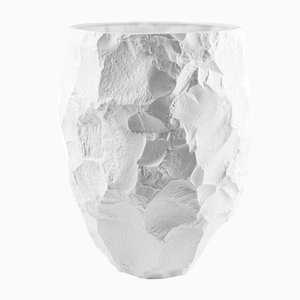
Britische Große Tiefe Schale aus der Crockery Serie von Max Lamb für 1882 Ltd
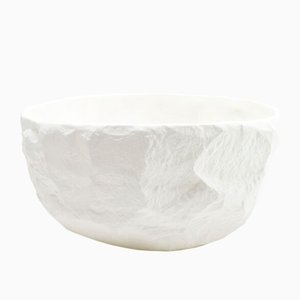
Große Flache Schale aus Schwarzem Basalt aus der Crockery Serie von Max Lamb für 1882 Ltd
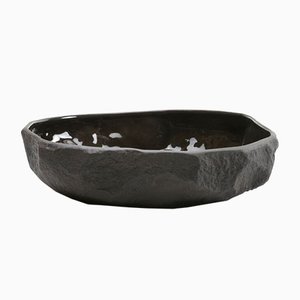
Große Tiefe Schale aus Schwarzem Basalt aus der Crockery Serie von Max Lamb für 1882 Ltd

Schwarzer Basalt Salz & Pfefferstreuer aus der Crockery Serie von Max Lamb für 1882 Ltd

Mittelgroßer Servierteller aus der Crockery Serie von Max Lamb für 1882 Ltd
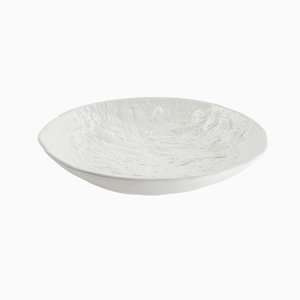
Hohe Vase aus der Crockery Reihe von Max Lamb für 1882 Ltd
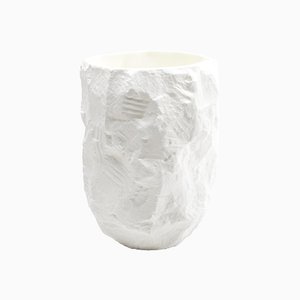

















 White Lies by Nick Ross
© Nick Ross
White Lies by Nick Ross
© Nick Ross
